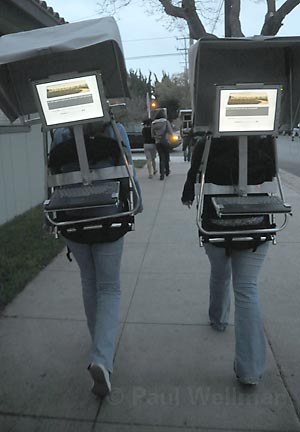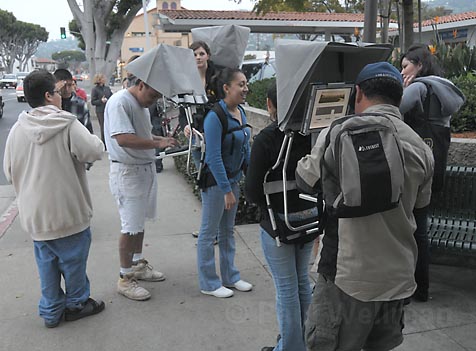SBMA’s Electronic Poetics Brings in the Community
Thinking Inside the Box

What could you do with an 8-foot-by-24-foot storage container? If your first answer is “store stuff in it,” think again. The real question is, “What can’t you do with an 824 storage container?” For the third year in a row, the Santa Barbara Museum of Art, in collaboration with UCSB, has been working with schools and other community organizations to transform what was once a lowly storage unit into something completely unexpected. The container was originally transformed into a traveling gallery for the SBMA show Labor Exchange, and was reincarnated last year as The Tamayo Mobile in concert with the museum’s Rufino Tamayo exhibit. This year, the container is touring as a part of the Electronic Poetics project, in which it serves as a mobile arts lab, gallery, classroom, and theater.
Today, February 21, the Electronic Poetics container comes home to SBMA for more than two weeks, allowing the public to interact with the project and the artists, just as students across the county have been doing since January. Electronic Poetics was most recently located at Casa de la Raza community center, where it had been lifted into the back patio by crane, and where it served as classroom and launching pad for a 10-week after-school program on digital art. The program was led by Jane Mulfinger, who also teaches in UCSB’s Department of Art and College of Creative Studies.

As part of that program, students were introduced to the REGRETS project, a digital art experiment organizers describe as “an interactive archive, public artwork, and study regarding the human capacity for remorse.” On the day of a recent class, two mobile computers, attached to backpack frames and screened for privacy, hung from the doors of the container, transforming it into a computer lab where students entered their own regrets into the database and explored the answers given by other members of the community. As they worked, digital regrets from the collection scrolled across one of the walls of the container. The students also tried on the mobile “regret collectors” in preparation for field trips to Milpas and State streets, where they invited members of the public to enter in their regrets.
Later, the same students lounged in comfort on the padded seats that unfold from the entrance of the container, allowing it to double as a mini auditorium. Santa Barbara artist Billy Hood gave a presentation about recent art projects he had been involved in, including Open Container, the UCSB project to transform two storage containers into a living space. Hood illustrated his talk with images from a data projector that hangs from the container’s ceiling. After the talk, students visited the Casa de la Raza computer lab, where they were introduced to SketchUp design software. They were soon rotating images of their own storage containers in three dimensions as they worked on projects they will enter in the Open Up the Box competition sponsored by storage company J Staal and UCSB.
While Electronic Poetics is at the museum, the public will have a chance to participate in the REGRETS project, attend programs in the space, and view the art being produced there while it serves as studio to visiting artist-in-residence Isabel Barbuzza. Barbuzza will work with Santa Barbara High School’s Visual Arts and Design Academy students and the SBMA teen interns to create an installation in the container. Her work, which explores issues of globalization, reuse, and cultural and personal identity, dovetails with the Identities exhibition currently on view at SBMA.
Later this year, the container will visit a number of other sites, including several campuses of La Cuesta Continuation High School, the Isla Vista Teen Center, and the Guadalupe Community Center, where it will serve as a space to show films, have poetry readings and other performances, and display student art.
If it seems like Electronic Poetics encompasses just about everything, that’s the whole point. As Patsy Hicks, who coordinates the project for SBMA, explained, “There are all kinds of possibilities. You could see it as a Rorschach test for the community; whatever you put into it is what it becomes.” Hicks pointed out that the workshops associated with Electronic Poetics are based around a series of core questions: “How do you use the most contemporary technology to express yourself? How does language tie into art and how we see ourselves? How can we create art and be more conscious of how to reuse things and be green?” But such questions are just the beginning of an open-ended exploration. “It’s the reverse of Pandora’s box,” Hicks observed. “With Pandora’s box, when you open it, everything good leaves, but in this case, you start with a box that’s empty and all the good stuff flows into it. Without the box, the people would not have come together.”
4•1•1
Electronic Poetics will be in residence at SBMA (1130 State St.) between February 21 and March 6. For more information, call 884-6432.



